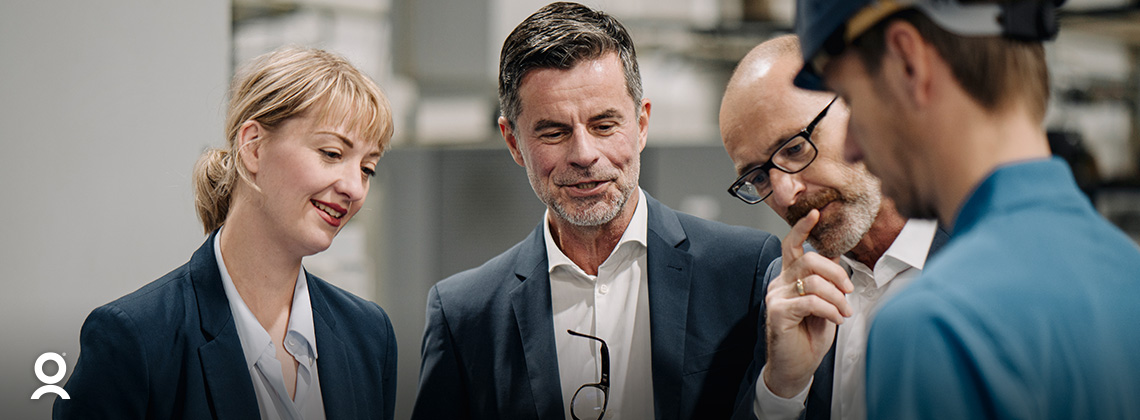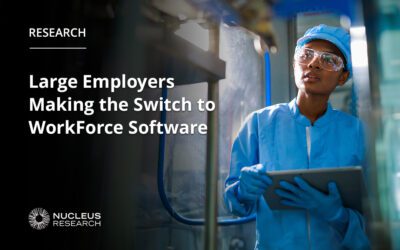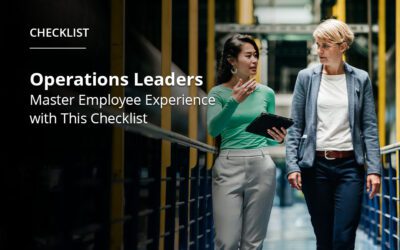4 Tips to Bring Organizational Change from Other Trailblazers

Acting as an agent of change is vital in today’s rapidly evolving world. Embracing this role brings numerous benefits, such as fostering a culture of continuous improvement, inspiring others to embrace change and unlocking new possibilities for growth and success. To enable success for those looking to impact organizational transformation, we’ve compiled insightful tips on how to build momentum for change, find and cultivate allies and the importance of leveraging diverse thinking and teams to make a lasting, meaningful impact.
Build a case for change in your organization with the Workforce Experience Activation Guide
During our VISION 2023: Essentials Conference, Sandra Moran, Chief Marketing and Customer Experience Officer at WorkForce Software, hosted a special breakfast session, “Be an Agent of Change – Tips from Other Trailblazers.” Joining her were Nicole Neumarker, Chief Technology Officer at WorkForce Software, Paula Robinson, Delivery Manager at GroupeX Solutions, and Mark Bryner, Product Director, HR and Payroll at CONA (Coke One North America).
Together, these trailblazers empowered attendees to become a change agent within their organization. We’ll look at how the experience and strategies shared by our panelists inspired attendees and equipped them with plans to advocate for their organizations’ future of work.
Tip #1 – Embracing Adaptability
Sandra led the discussion, explaining that now is the time to act and create profound change in the workplace using the resources that are available today. To this end, she highlighted key attributes that define change agents, placing a high value on adaptability. Being able to recognize adaptability in others is essential when connecting with other change agents. This serves as a call, not only as a means of individual growth but also as a strategy for navigating the individuals important to driving change.
“Someone’s skill is not as valuable as their ability to learn. Adaptability is one of the most important characteristics in today’s environment.”
Sandra Moran, Chief Marketing and Customer Experience Officer, WorkForce Software
Likewise, adaptability becomes essential when encountering barriers to change, especially since often, these barriers include other people within the organization. Ushering in change can often mean coming to teams who are passionate about what they do with new and unfamiliar processes. There are always reasons why internal stakeholders may be resistant, but having an adaptable mindset allows for new possibilities. Sandra explained that here is no mechanism by which you can get past the why, but we can reprioritize our goals in a way that makes sense. Learning to listen, engage, and be curious fosters personal connections that contribute to compromise and resolutions rather than stagnation.
Tip #2 – Building Consensus for Change
One of the greatest challenges in making change a reality is garnering support and building consensus from stakeholders within an organization. Panelists emphasized the importance of taking the time to connect and empathize with those who would be directly affected by new processes or standards.
To this end, Mark advocated for the power of active listening as a critical aspect of change. Rather than imposing change, he advocated for building consensus by addressing peoples’ concerns and involving them in the decision-making process. By understanding their perspectives, change gains more meaning and impact.
“I think listening to people is a critical part of change. People are not change they just have concerns.”
Mark Bryner, Product Director, HR and Payroll at CONA (Coke One North America)
Paula explained that the challenge is learning how to bring others along, “Not just initiating change myself, but inspiring others to do the same.” If done effectively, teams that were initially resistant can become more open about sharing their processes and understanding their needs allows you to define concrete pathways to bring change. “Empathy is a big part of what we do. “You’re putting yourself in someone’s shoes, understanding why the resistance is coming up.”
Tip #3 – Leveraging Existing Momentum
Nicole stressed the importance of leveraging existing momentum for change. For instance, when she needed to develop an enterprise-wide strategy, she often looked through the organization to identify teams who were already doing the things that no one else was. “If you need help, look for people who are helping. I’m a huge fan of taking existing momentum of where you can find it and riding the wave.”
Nicole also recommended recognizing individuals who are taking the right steps to let others see what good looks like. Identifying and elevating change agents, those who are already excited for the kinds of change you want to see, creates a snowball effect that allows others to follow along.
“There are always people in your organization who are ready to lead change. Tap into the 20% that are ready to go and the 80% will follow along.”
Nicole Neumarker, Chief Technology Officer at WorkForce Software
Additionally, Nicole highlighted the value of reinforcing flexibility. As new processes are implemented at scale, it becomes easy to get focused on individual processes without understanding the big picture.
Tip #4 – Navigating Toward End Goals
Paula stressed the importance of keeping the end goal in mind throughout any project. She acknowledged that when faced with obstacles, it’s easy to feel discouraged and distant from the desired outcome. “Any project you’re working on, you’re always looking at the end goal. When you hit bumps, it’s easy to feel like the goal is so far away.” Paula suggests redefining success and celebrating small milestones along the way. This creates momentum and motivates the team to move forward.
To make change tangible, seek evidence of its potential impact. Rather than focusing on the unknowns, finding and promoting use cases that demonstrate the real value of a desired change can help identify success markers and convert skeptics into advocates.
“When change is going to take a long time, I search for testimonials of what change will look like. It’s important to find pieces of evidence that show we’ll get there.”
Paula Robinson, Delivery Manager at GroupeX Solutions
Becoming an effective agent of change requires a willingness to engage with your organization, leverage existing momentum, and communicate how actions taken today contribute to a desired end state. Staying adaptable and empathizing with others can serve to transform barriers and blockers into concrete strategies that move the needle forward. Sandra, Paula, Mark and Nicole’s valuable insights offer a roadmap for driving change within an organization. By embracing their advice, we can navigate the complexities of change and make a positive impact on our teams and organizations.
Global Employee Experience Study offers data-driven insights into the kinds of change that can enable true workplace transformation. Read this report to gain further knowledge about employee job training, scheduling, pay rates, recognition, feedback and communications.
Subscribe to The WorkForce Blog
Learn the art and science of maintaining productive, happy, engaged employees.
Discover More
Nucleus Insights from WorkForce Customers Research Note
Nucleus Research interviews WorkForce customers who validate why we’re ranked the #1 WFM enterprise vendor for 10 consecutive years.
Elevate Employee Experience: Checklist for Operational Leaders
Get the practical steps and technology functionalities operation leaders need to improve their employees’ work experiences.
Streamlining Complex Workforce Compliance Requirements Boosts Productivity
Discover how workforce compliance software helps EMEA organisations navigate complex legislation, enhance compliance and boost operational efficiency.



